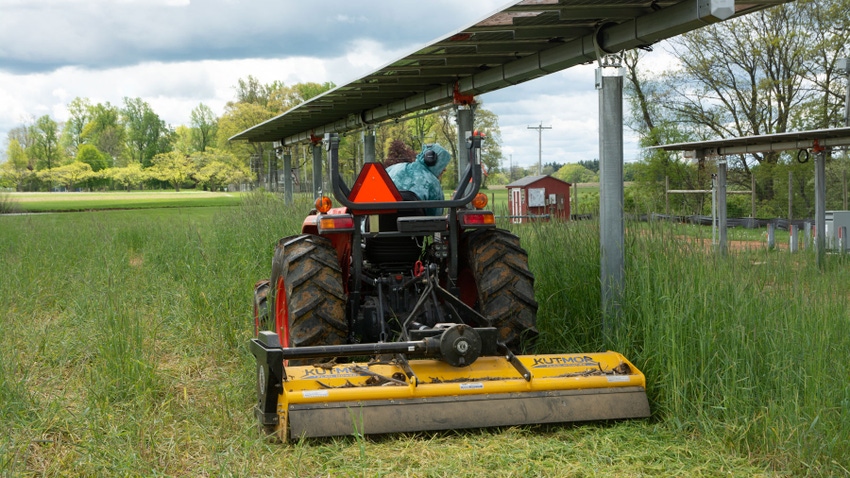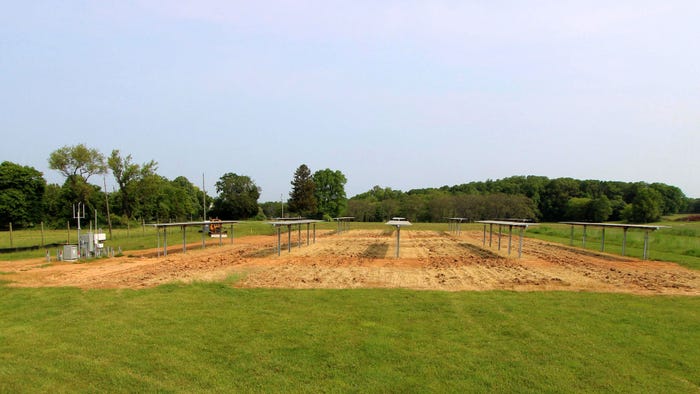
There is no doubt producers have a love-hate relationship with solar.
Yes, money can be made from the installation of solar panels. But it also means replacing farmland — oftentimes prime farmland — with thousands of these panels.
In New Jersey, where the government has an ambitious plan to convert to 100% renewable energy by 2035, a good chunk of the state’s 750,000 acres of remaining farmland — 220,000 acres are permanently preserved — could be converted to solar installations in the future.
“It adds up to quite a bit of ground,” says David Specca, the Rutgers Agrivoltaics Program lead.
He and others are looking at new designs to see if solar panels and production farming can co-exist in the Garden State and beyond.
The New Jersey Board of Public Utilities recently announced an agreement with Rutgers to develop a Dual-Use Solar Energy Pilot to demonstrate and study the compatibility of agricultural and horticultural production with solar panels.
It is hoped that the results of the pilot will lead to permanent standards for constructing and operating dual-use solar projects — ones that will produce electricity and enable farming. It will also provide incentives for constructing dual-use systems on unpreserved farmland in the state.
New technology
Two demonstration projects are already up and running on two of Rutgers’ ag research farms.
At the Clifford E. and Melda C. Snyder Research and Extension Farm in Pittstown, N.J., a 210-panel project at 32-foot row spacing has been completed.
Another 567-panel project — 34-foot row spacing — at the Rutgers Ag Research and Extension Center in Bridgeton, N.J., soon will be completed.
Specca says 32-foot spacing can easily accommodate hay-cutting equipment.
Both these projects, he says, are testing single-axis tracking systems that, via control box, can mechanically move from east- to west-facing following the sun’s position in the sky. Depending on what the panels are made from, the hope is that each can capture more energy.
Specca says the panels can be manually controlled from a smartphone app, so if a producer would need them configured in a certain direction for fieldwork, they would be able to do that.
A third project that will break ground next month is testing a type of solar technology Specca says is a first for the U.S. A vertical bifacial system — also called a solar fence — will be installed at the Rutgers Animal Farm in New Brunswick, N.J. The specs of the project include 378 panels at either 20- or 40-foot row spacing, with capacity to generate 170 kilowatts of electricity.

TESTING NEW TECH: A single-axis tracking solar system can mechanically move from east- to west-facing following the sun’s position in the sky. Depending on what the panels are made from, the hope is that these panels can capture more energy.
Specca says the project is designed to look at the effects of solar on an animal operation and whether they can co-exist.
The panels, or fences, come from a German solar company. Both sides of a bifacial module have a glass surface that captures the sun’s rays. But its vertical installation means that it will not be able to capture sunlight at midday.
Still, Specca is intrigued by it, especially considering that, at least on paper, they could be less obstructive to a farming operation and less visible on the landscape. But again, it all comes down to how much sunlight they can capture.
Solar 2.0
Jesse Robertson-Dubois, director of sustainable solar development for BlueWave, a solar installation company founded in 2010, describes the next generation of solar installations on farms as solar 2.0.
He says BlueWave has four agrivoltaics projects — the co-location of solar installations and agriculture beneath or between rows of photovoltaic panels — under construction on farms in Massachusetts.
One project is focused on a butternut squash producer who will grow crops under a 10-foot-high single-axis tracker system.
Another project in Palmer is looking at hay production and cattle grazing on a farm with the same 10-foot-high single-axis tracker system with 25-foot row spacing between posts and 17 feet of clearance between panel edges when horizontal.
Robertson-Dubois says the system is designed to accommodate a tractor with a standard 9-foot side-pull mower conditioner and an 18-foot hay tedder. Cattle will then be able to graze unmown strips directly under the panels.
“It just fits well as a good way to continue to harvest that area,” he says. The panels are also potentially more energy-efficient than the typical south-facing tilt systems found on most solar farms, with the ability to produce 20% to 30% more energy due to its ability to capture more sunlight.
This is important, he says, because more energy production is needed to offset the increased costs of a single-axis system.
While solar fences are intriguing, he thinks they likely work best on more specialty operations, such as an orchard or vineyard, where solar panel height can be detrimental.
Saving farms
Robertson-Dubois, who also farmed and worked for American Farmland Trust, acknowledges that too much farmland has been lost to solar projects the past couple of years.
As a result, some local ag communities, in response to losing farmland, have placed what he describes as onerous requirements on solar projects that make agrivoltaics more challenging to design.
For example, requiring large setbacks for solar projects takes away ground a producer could use to turn around a large machine, he says.
The industry, Robertson-Dubois says, should do a better job of selling systems that can produce energy and keep farmland in production.
“We can do better. We have to do better,” he says.
Specca hopes the dual-use pilot will show that solar and farming can co-exist. His own family lost 50 acres of land they farmed in central New Jersey after a neighboring farmer decided to put in a solar installation.
As a result, Specca says he had to cut back on number of crops grown, until he and his family bought a neighboring farm.
"I saw firsthand what it did. It took that productive farmland out of the picture," he says.
With more solar installations on the way, working with farmers to build out these projects and meet their agricultural needs is critical, he says. Otherwise, more farmland will be replaced by solar.
"That's just not palatable for our farmland in this state. Preserving that farmland to continue to be productive for us is critical,” Specca says.
Read more about:
SolarAbout the Author(s)
You May Also Like






